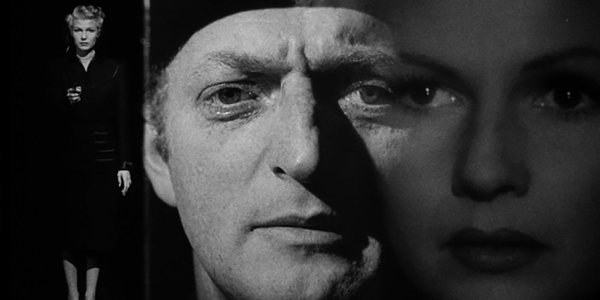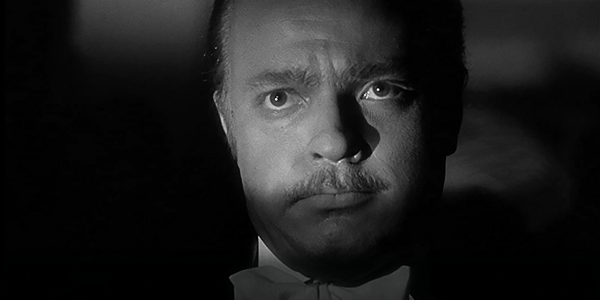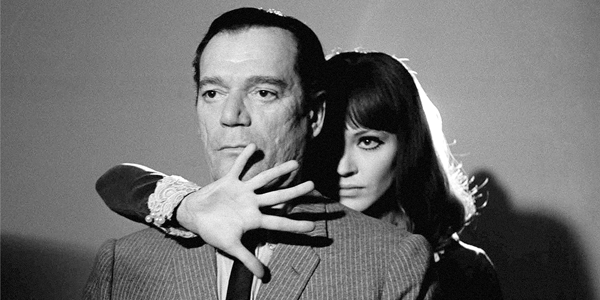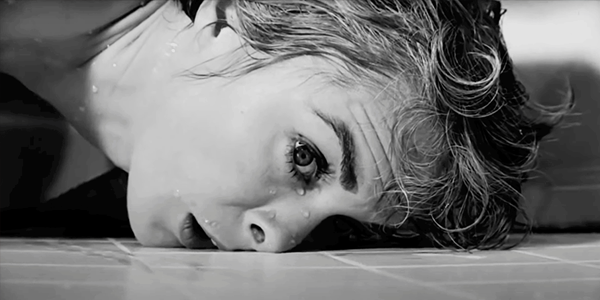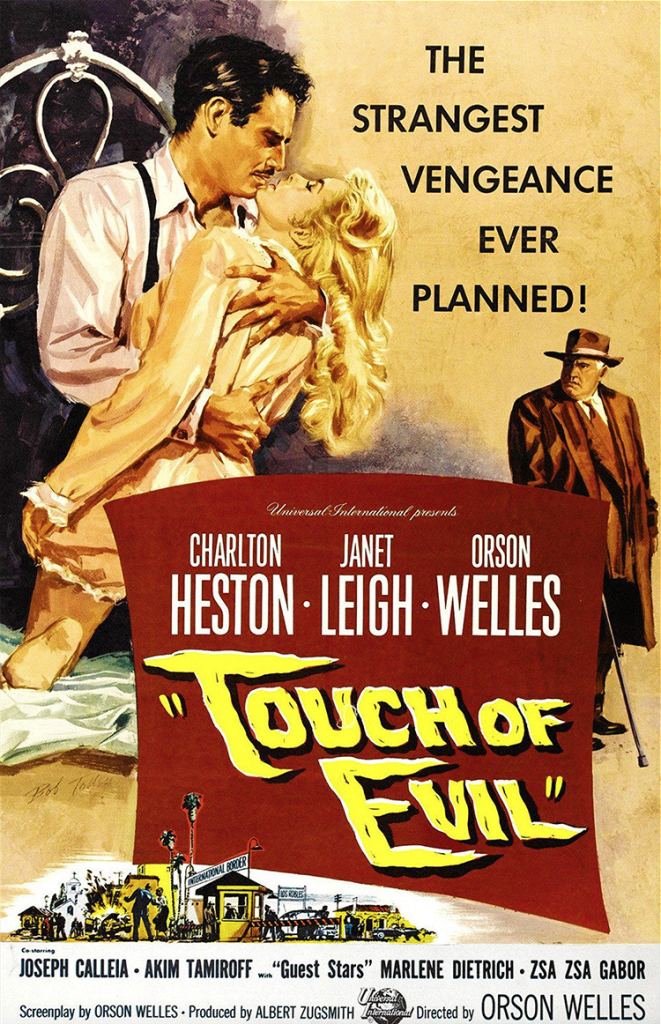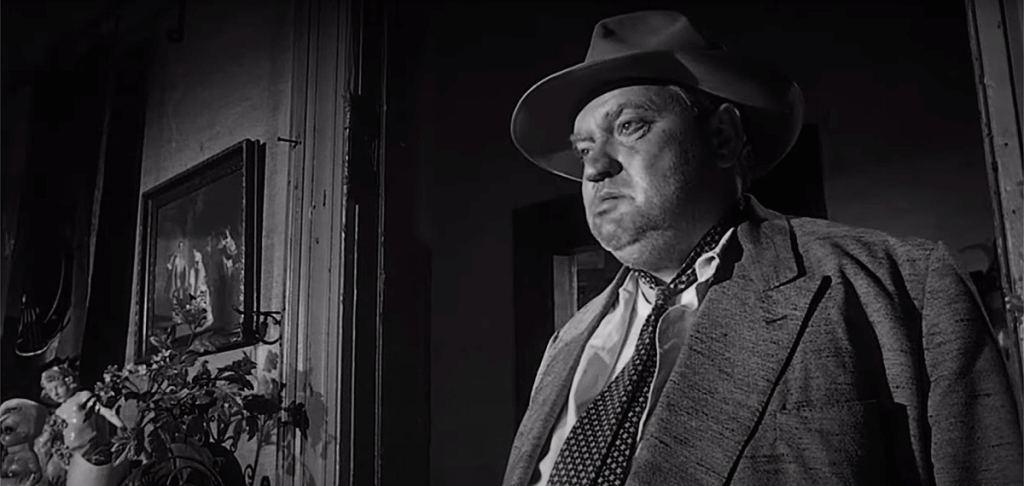
review | Touch of Evil
Orson Welles’ second-best film remains an evocative, engaging, disturbing, and visually stunning film noir
by Michael Gaughn
July 29, 2022
Labeling things, even if it’s to figure out who’s done something best, is usually a great way of robbing them of their essence because the exercise inevitably makes the best of whatever seem too much like other, more mediocre things when the whole point ought to be to highlight what makes them stand out because they’re different—unique. That said, the best film noir is probably the first, Double Indemnity; the most perverse—because it caused the genre to start eating away at itself from within while it was still in its prime, introducing a fatal dose of doubt into a genre that was already all about doubt—is, hands down, Kiss Me Deadly. And the ultimate expression of noir as stylistic exercise while also being its deepest and most troubling character study is Touch of Evil.
We usually associate style with something superficial, and that’s usually a pretty safe bet to take, especially if we’re talking about any of the giggly, pointlessly gruesome, less-than-human recent stuff that crows itself as neo-noir. But the genius of Evil—Welles’ genius—was to take every element of the film and set it in counterpoint, in the Baroque sense, with every other element. Nobody had done that in a noir before (or has since), and the instances of it in other genres are sadly few. And it’s the furious texture Welles created—both rough as sandpaper and smooth as silk—that makes Evil inexhaustible, as evocative and engaging and disturbing a film now as it was when it was released—in studio-butchered form, of course—in 1958.
And we should all be grateful the studio held sway here—that is, if the so-called director’s cut is any indication what Welles would have wrought if given his editing druthers. Somehow I doubt that last part. The misguided attempt to be true to the long-deceased filmmaker’s intentions—in other words, to read his mind by reading his notes—smacks of being an unimaginative academic exercise leagues removed from Welles’ brilliance. But a lot of people lap up whatever comes out under the “director’s cut” moniker as gospel, without ever stepping back to figure out whether it adds up to anything worth watching.
The studio’s edit actually enhances Welles’ grand design, keeping the film moving in a heedless head-long rush that subsumes anything that might have smacked of pretentiousness into the larger mission. That can’t be said of the sputtering. lumbering director’s cut. And, fortunately, it’s the studio version you get, in 1080p, when you view Evil on Amazon Prime.
Again, saying some film is the most or the best of anything is usually just so much critical bloviation. Too many films have now been made by too many only meagerly talented people, hopelessly muddying the waters, for those words to mean much. But Evil deserves to be placed with some rarefied company, is one of the very few movies where if you say something’s about it’s the best, that word still has some relevance and weight.
In a genre that tends to invite visual flamboyance and outright excess, this is a tough call to make but, of all the noirs, Evil is the most visually stunning. And that’s not just because Welles’ feverish conceptions and cinematographer Russell Metty’s ferociously inspired realization of them succeed in creating a plausible and engrossing twilight world of corruption and menace, but because, for all its exuberance and smart-assery, that visual canvas is integrated into every aspect of the production in a way that’s mutually reinforcing. (Again, that counterpoint.) In other words, it’s all meant in the service of art and not of just showing off.
Metty was a master of both black & white and color—consider his still unmatched work on such Douglas Sirk films as Written on the Wind, Imitation of Life (1959), and, especially, All That Heaven Allows. And having him more than ably manning the camera gave Welles an expressive freedom he hadn’t had since his collaboration with Greg Toland on Citizen Kane. Metty gave Welles wings—and some badly needed discipline.
But putting so much emphasis on the visuals suggests the audio somehow takes a back seat. It’s doesn’t. It, like every other element in the film, is co-equal, and the mix, not in terms of technical quality but of aptness to the material (which is all that should really matter) is pretty much peerless. The sound has as much to do with evoking the relentlessly grimy border town of Los Robles as any of the imagery, and the use of sound during the prolonged climactic scene where Vargas deploys Quinlan’s deputy with a wire so he can lure Quinlan into incriminating himself is both subtle and dazzling. No amount of surround gimmickry could ever improve its impact.
And we meet up with Henry Mancini again, here in his breakout film. Known for his smooth, clean style, this is Mancini at his dirtiest, delivering a perfectly apt soundtrack that’s surprisingly gritty and raw. It’s a kind of warmup to his equally loose tracks for Peter Gunn later that year, but without the mitigating dollop of cool.
At its heart, Evil depicts an almost Darwinian struggle as one group / culture / generation supplants another. And it’s a tale of the Fall, as idealism comes up against the tangled complexity of reality and, as it always does when it tries to impose rather than adapt, breaks apart on the rocks, taking down everyone on board. Welles constructs a fiendishly nuanced moral labyrinth of a kind Hollywood films aren’t built to sustain, ruthlessly questioning everything, but showing an amazing compassion for people who remain true to their innate sense of duty, even when it leads to their downfall. A hell of a mature and discriminating statement from a pampered brat—and one he was incapable of making until this film.
All of which helps to explain why Evil is a kind of Citizen Kane reunion, with many of the secondary roles populated by players from that film. Welles wanted to show how much he and movies had changed since he naively burst on the scene—and then got his head handed to him.
Evil is also a film about faces—even more so than Dreyer’s Joan of Arc—and therein lies its redemption. Every person on screen displays character. While some of the roles might be stereotypes, Welles cast the film so every actor, by their presence alone, could rise above those stereotypes. Which once again brings us to ethnicity, and all I can say about that here is: Charlton Heston is offensive as a Mexican because he’s a bad actor who doesn’t understand the character he’s been asked to play. Akim Tamiroff is brilliant as a Mexican because his Uncle Joe Grandi is fully dimensional, expresses his history and being with his every gesture and word—which is all that ought to matter if you’re trying to create, first, fiction and then art, and not propaganda.
Touch of Evil is, on more than one level, so relentlessly bleak it would be impossible to sit through it if wasn’t balanced by the elegance of its camerawork and wit of its score, and if it wasn’t redeemed by its love of its characters, its humor, and the honesty of its portrayal of inevitable human failing.
Michael Gaughn—The Absolute Sound, The Perfect Vision, Wideband, Stereo Review, Sound & Vision, The Rayva Roundtable, marketing, product design, some theater designs, a couple TV shows, some commercials, and now this.
© 2025 Cineluxe LLC


